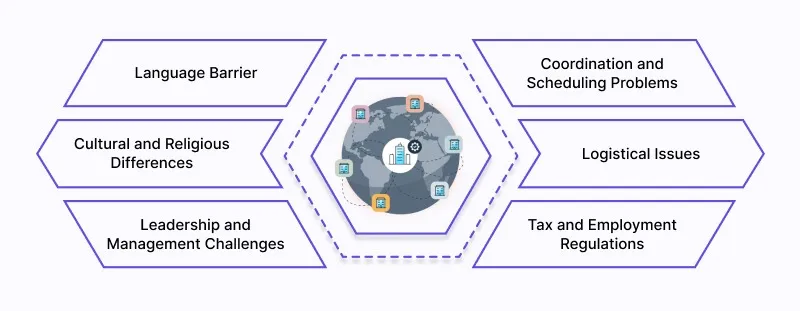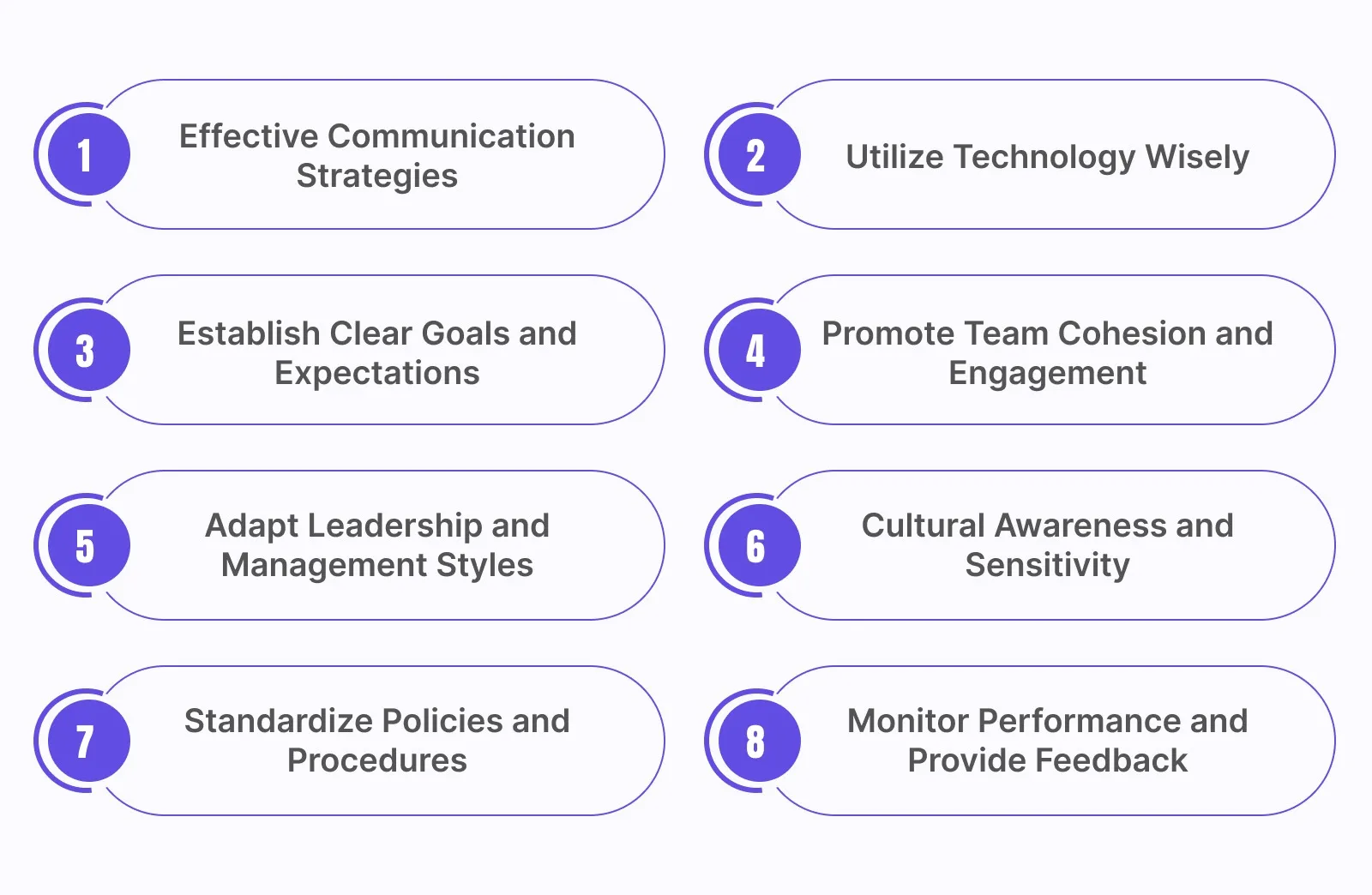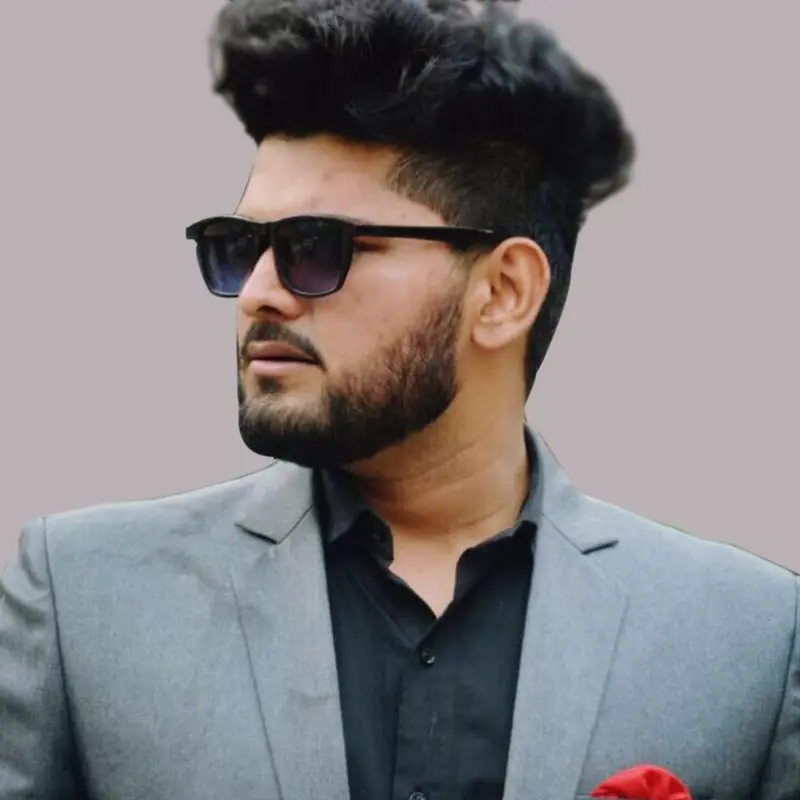Table of Contents
Introduction
Managing a team across multiple locations can feel challenging, but it is essential for today’s globalized workforce. Multi-location employee management is complex, involving project scheduling across different time zones and organizational cultures.
Did You Know?
88% of businesses have implemented workforce management software, highlighting the importance of these tools in promoting efficient operations and capable staff management.
Thus, with growing businesses and increasing usage of remote work, executives have to overcome several significant challenges to maintain employee communications and productivity.
This blog will cover the best advice on addressing these issues of managing multiple locations effectively and transforming your distributed team into an optimal performance engine.
Whether your organization has offices in different cities or no offices at all and fully employs remote workers, the best practices provided here will assist in increasing work consistency and organizing interactions between teams.
Let’s get into it
What Is Multi-Location Workforce Management?
Multi-location workforce management is the practice of managing workers who are located in different regions, cities, or even countries. It effectively oversees employees in different workplaces or who work from home by ensuring they work towards organizational objectives as a team while observing the physical barrier.
Key Characteristics
Geographical Dispersion: With employees across various regions, management must frequently navigate time zone differences, cultural diversity, and regional business practices.
Technological Integration: Technology integration helps connect, share, and organize multiple work processes involving distributed teams. This includes video conferencing, cloud, project management, and virtual communication tools.
Diverse Cultural Dynamics: To promote strong working relationships, team managers from diverse regional and cultural backgrounds must understand each culture’s verbal and nonverbal cues.
Flexibility and Adaptability: While enforcing uniform standards and rules throughout the company, multi-location workforce management must handle various local laws, labor regulations, and corporate settings.
Benefits
Access to Global Talent Pool: It helps link organizations to diverse, talented human resources across various geographical locations, thus providing access to a pool of specialized skills.
Cost Efficiency: Cutting down the need for offices and having workers work remotely will likely reduce rentals, energy usage, and maintenance expenses.
Enhanced Productivity: Employees can choose where to work, making it easier for them to work in the available space they feel comfortable working in when it is convenient.
Market Expansion: Having offices in various places means that organizations can penetrate the market further, reach customers more, and respond to market needs more suitably in different locations.
Thus, in a globalized economy, managing a multi-location workforce offers the potential for enhanced efficiency, effective procedures, and improved organizational performance. Now, let’s move ahead to the challenges associated with multi office workforce management.
Common Challenges In Multi-Location Workforce Management

Here are common challenges in multi office workforce management:
Language Barrier
Many multinational companies face language barriers when managing global workforces. Every person can’t be fluent in more than one language, and in the modern-day workplace, people from different countries and cultures may work in the same building. A common or shared language, such as English, is often used for communication, but this is not always true.
Cultural and Religious Differences
Not everyone comes from the same background, just as not everyone speaks the same language. Although this is usually positive, there may be challenges due to people from diverse backgrounds and experiences.
Leadership and Management Challenges
Managing and supervising remote employees usually challenges leadership, trust, and communication. Since communicating and monitoring employee performance physically is inconceivable, remote employees require clear performance appraisal systems.
Coordination and Scheduling Problems
Multiple locations create unique issues, such as coordinating shifts and ensuring enough individuals to fill them. Assigning organizational assets, including equipment and support personnel, across different locations raises key issues of facility layout and coordination.
Logistical Issues
As an international business with multiple sites, there are exciting and challenging aspects to consider. Managing a global workforce involves addressing different time zones and providing detailed travel itineraries.
Tax and Employment Regulations
Employment laws and taxes differ from country to country and possess predefined procedures and formalities. This can impact things like holiday entitlement, benefits, wages, etc. As a result, your company must understand and abide by the specific tax laws and human resource obligations that apply to each nation.
After learning the common challenges of multi office workforce management, it’s time to learn tips for overcoming these challenges.
Tips To Overcome Multi-Location Workforce Management Challenges

Follow these tips to overcome multi-location workforce management challenges:
Effective Communication Strategies
Set up integrating communication methodologies that will effectively address time and cultural differences. Organize real-time and non-real-time communication to enhance clarity and response capability for geographically dispersed team members.
Utilize Technology Wisely
Effective technology management ensures firms harness technology solutions, including video conferencing, project management, and collaboration tools. These tools should enable efficient communication, filing, and collaboration across different sites.
Establish Clear Goals and Expectations
Establish specific goals, objectives, and performance standards for virtual workers. To keep everyone in check, focus on clear communication of the goals, expectations, deadlines, and project progress.
Promote Team Cohesion and Engagement
Promote remote workers’ togetherness and identity via virtual team bonding occasions, daily/weekly communication, and other communication methods. Focus on maintaining and improving close-knit relationships in cross-geographical fields.
Adapt Leadership and Management Styles
Implement dynamic leadership and management styles that support the remote workforce context. Equip the remote managers with tools for monitoring, motivating, and engaging the employees in other locations.
Cultural Awareness and Sensitivity
Encourage cultural sensitivity to reduce conflict and ensure effective work relations for multicultural groups. Introduce cross-cultural training and facilitate policies addressing conflicts to foster understanding and respect.
Standardize Policies and Procedures
Establish uniform general policies and directions while accommodating different regional legal demands. These policies may include issues regarding remote work, performance evaluations, and data security in various countries.
Monitor Performance and Provide Feedback
Organize performance appraisals and feedback sessions to ensure that they are reliable measures of remote teams’ performance. Reward and encourage workers, give positive and negative feedback on their performances, and review worker performances to ascertain their productivity.
Simplify Multi-Location Workforce Management With Workstatus
Some advantages and disadvantages are generally considered when managing employees spread throughout multiple regions. Workstatus provides efficient solutions to address these issues and makes it easier for CEOs and founders to manage their workforces.
Here is how Workstatus can simplify multi office workforce management:
Challenge #1 – Communication Breakdowns
Solution – Accurate Time Tracking: Workstatus provides accurate, effective time tracking tools that help managers guarantee that each team member records his work schedule appropriately, regardless of the place. This increases communication for time zones by offering insight into who has been assigned to the project and when.
Challenge #2 – Coordination and Scheduling Difficulties
Solution – Efficient Shift Management: Workstatus makes it easy to work with shifts by providing simple and easy-to-use scheduling tools. It eliminates timetable clashes and offers satisfactory coverage for all sites. These tools are often useful in helping managers create, edit, and share shifts and ensure that all employees know them, thus minimizing confusion and late changes.
Challenge #3 – Leadership and Management Challenges
Solution – Seamless Online Time Reporting: Utilizing Workstatus, online time reporting is incredibly easy and convenient. Management can obtain specific reports on employees’ working time, activity achievements, and efficiency levels without delay. The availability of real-time information also enables managers to make correct decisions and give feedback to their subordinates at the right time.
Challenge #4 – Performance Monitoring and Accountability
Solution A – Comprehensive Workforce Optimization: Workstatus offers detailed solutions to workforce management that can help leaders efficiently track performance. Analytics and reporting tools enable evaluation of employees’ results, strengths and weaknesses, and overall team effectiveness. This level of insight provides some form of accountability and assists in strategic planning.
Solution B – Flexible Employee Scheduling: The Workstatus feature enables the organization to schedule employees more flexibly by acknowledging time zones, choice of working hours, and regional differences. Such flexibility allows all employees to be well-scheduled for work based on their availability and organizational needs, thus increasing productivity and employee contentedness.
Best Practices For Managing Multi-Location Workforce

Clear Communication Channels
Improving communication channels is the first and most important step in managing multi-location employees. Coordinate the group and make sure everyone is connected via communication platforms such as Slack, Microsoft Teams, or Zoom. Employees are always notified through emails, newsletters, or meetings, and feedback channels such as surveys or ideas boxes enable employees to share their information and views.
Standardized Processes
It is especially important to follow standard procedures where you have multiple facilities. Developing standard operating procedures also involves writing down the procedures followed in planning for work and which workflows should be used. Systematic training structures guarantee that company employees are provided only standard knowledge and skill enhancement irrespective of their remoteness.
Technology Integration
A business organization needs to adopt technology to function effectively in different branches. Implement shared databases, such as cloud technologies, to store information in one place and make it available to all locations. Remote working software, such as Workstatus, allows for cooperation and coordination when working in different locations.
Local Adaptation
Local adaptation concerns culture and differences within various regional areas. Each strategy should be specific to the local market and workforce to retain general company standards and be relevant and effective.
Strong Leadership
It also requires leadership input to manage employees in various locations effectively. Recruit managers who understand the firm’s vision to oversee their subordinates. Senior leaders should also ensure that they move frequently to check on issues that employees are facing.
Performance Monitoring
Performance monitoring refers to comparing the degree of compliance to the standard measures used in the different locations. Scheduled appraisals and communication facilitate constant development and keep everyone on the right track regardless of the place of work.
Employee Engagement
A motivated workforce is essential, so engaging employees should be a priority. Schedule group activities, whether remote or face-to-face, to foster togetherness. Use promotions and bonuses to motivate employees and increase productivity and their levels of commitment.
Flexibility and Adaptability
Managing workers in multiple locations requires flexibility and adapting to change. Establish a set of guidelines that may vary from one local to another depending on the circumstances. Ensure you have proper strategies to follow because crises can occur anytime.
Case Studies Of Managing Multi-Location Teams
Here are some case studies of managing the workforce among several offices:
Case Study 1: IT Services Company
An IT services company in several countries adopted Workstatus due to global workforce management needs. With the help of Workstatus, they found that time tracking and project management were made much easier due to having multiple time zones to consider. The software also offered detailed reports and analyses, which were vital in allocating resources and increasing efficiency in the company.
Case Study 2: Marketing Company
A marketing agency with teams in different cities implemented Workstatus to improve their project and team efficiencies. Using Workstatus, the agency could view the timelines for different projects, employee performance, and deadlines equally. The task management features enabled the team leaders to assign and track the tasks. This facilitated the flow of work despite the team members being located in different regions. The agency increased client satisfaction as evidenced by the efficiency and timely delivery of projects.
Case Study 3: A Health Care Organization
A healthcare organization with clinics in different areas employed Workstatus to address the complexity of its workforce composition, which comprises doctors, nurses, and support staff. Through Workstatus, the organization achieved better schedules because all clinic posts were always occupied. The features that captured work hours, calendar, and leave applications lessened administrative time and enhanced efficiency.
Closing Thoughts
Therefore, workforce management in a multi-location company is about unity of command, direction, and effort, focusing on technological advancement. It is important to support local leaders, maintain compliance, and leverage tools like Workstatus for better management.
Through training, performance evaluation, and promotion of employees’ participation, corporations can counteract obstacles and promote effective cooperation, improving the organization’s performance.
Effective management and strategic planning can minimize the adverse consequences of complexity and use them for further achievements in the modern world economy.
FAQs
Q. How do we maintain consistency in operations across multiple locations?
Ans. Establish clear policies and practices that define lines of work and expectations for all regions. Implement web-based applications to unify data and processes and strengthen data storage and access centralization.
Q. What strategies can we use to empower local leaders in different regions?
Ans. Top management should establish leadership development programs that conform to the firm’s values and objectives while accommodating the local environment. These programs should enable top leaders at the regional level to take responsibility and make appropriate decisions consistent with the global goals set.
Q. How can we monitor performance and ensure accountability across dispersed teams
Ans. Employ universally agreed performance measures and Key Performance Indicators (KPIs). Use applications like Workstatus to monitor working hours, project progress, and other parameters. Monitor performance information and give appropriate feedback to ensure excellent results are achieved.












